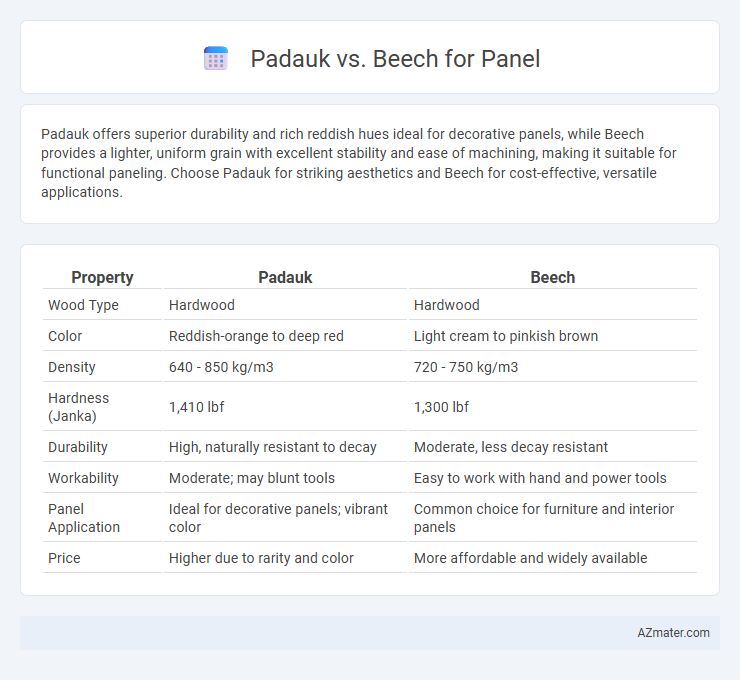Padauk offers superior durability and rich reddish hues ideal for decorative panels, while Beech provides a lighter, uniform grain with excellent stability and ease of machining, making it suitable for functional paneling. Choose Padauk for striking aesthetics and Beech for cost-effective, versatile applications.
Table of Comparison
| Property | Padauk | Beech |
|---|---|---|
| Wood Type | Hardwood | Hardwood |
| Color | Reddish-orange to deep red | Light cream to pinkish brown |
| Density | 640 - 850 kg/m3 | 720 - 750 kg/m3 |
| Hardness (Janka) | 1,410 lbf | 1,300 lbf |
| Durability | High, naturally resistant to decay | Moderate, less decay resistant |
| Workability | Moderate; may blunt tools | Easy to work with hand and power tools |
| Panel Application | Ideal for decorative panels; vibrant color | Common choice for furniture and interior panels |
| Price | Higher due to rarity and color | More affordable and widely available |
Introduction to Padauk and Beech Panels
Padauk panels, derived from dense tropical hardwoods renowned for their rich reddish-orange hues and exceptional durability, offer superior resistance to wear and moisture, making them ideal for high-traffic interior applications. Beech panels, sourced from European hardwood, are prized for their fine grain, light color, and uniform texture, providing a smooth, contemporary surface suitable for furniture and cabinetry. Both materials exhibit strong structural integrity, but Padauk's natural oils enhance longevity, while Beech panels are often favored for their ease of staining and adaptability in modern design.
Botanical Origins and Availability
Padauk, derived from the Pterocarpus genus primarily found in tropical regions of Africa and Asia, is prized for its vibrant reddish hues and dense grain, making it suitable for decorative panels. Beech, belonging to the Fagus genus native to temperate zones of Europe and North America, offers a pale, uniform texture widely available in commercial markets. Availability of Padauk is more limited due to its slower growth and tropical source, whereas Beech is more abundant and cost-effective, favoring mass production in panel manufacturing.
Visual Appearance and Grain Patterns
Padauk exhibits a rich reddish-orange hue with striking, bold grain patterns that create a vibrant, eye-catching panel surface. Beech offers a lighter, creamy tone with subtle, uniform grain lines that provide a smooth and consistent visual appeal. The contrasting colors and pronounced grains of Padauk make it ideal for statement panels, while Beech suits minimalist designs emphasizing natural simplicity.
Color Stability and Aging
Padauk offers vibrant reddish hues that maintain excellent color stability over time, resisting fading and darkening even with prolonged exposure to sunlight. Beech features a lighter, cream-colored tone that tends to yellow and darken as it ages, especially without proper finishing. For panel applications requiring long-term color retention, Padauk is preferred due to its superior aging resilience and minimal color shift.
Hardness and Durability Comparison
Padauk wood exhibits exceptional hardness, typically measuring around 1,410 on the Janka hardness scale, significantly surpassing Beech, which averages about 1,300. This superior hardness makes Padauk more resistant to denting and wear, ideal for heavy-use panels. In terms of durability, Padauk is naturally resistant to decay and insect attack, whereas Beech requires treatment to enhance its moderate durability in panel applications.
Workability and Machining Properties
Padauk offers excellent workability due to its moderate density and natural oils that reduce tool wear, making it easy to shape and sand with precision. Beech provides superior machining properties, with a fine, consistent grain that responds well to cutting, sanding, and finishing, ensuring smooth edges and stable panels. Both woods perform well in panel applications, but Padauk's natural oils enhance durability, while Beech excels in producing uniformly smooth surfaces.
Finishing and Maintenance Requirements
Padauk wood offers a rich reddish hue with excellent natural oils that enhance its finishing process, requiring minimal maintenance due to its resistance to moisture and insects. Beech wood features a pale, creamy color that absorbs finishes evenly but demands regular sealing and maintenance to prevent warping and discoloration in humid conditions. Both woods provide durable options; however, Padauk's lower upkeep needs and striking finish make it preferable for panels exposed to varying environments.
Cost and Market Value Analysis
Padauk offers a vibrant reddish hue with higher market value in luxury paneling due to its rarity, whereas Beech provides a more affordable and widely available option for budget-conscious projects. The cost per panel for Padauk is significantly higher, reflecting its durability and unique aesthetic, making it preferred for premium interiors. Beech panels maintain steady demand in commercial markets due to their moderate price and consistent quality, resulting in balanced cost-effectiveness.
Environmental Impact and Sustainability
Padauk wood, harvested primarily from tropical regions in Africa and Southeast Asia, offers notable durability but raises concerns due to deforestation and habitat disruption associated with certain logging practices. Beech wood, commonly sourced from sustainably managed forests in Europe and North America, tends to have a lower environmental footprint thanks to responsible forestry certifications like FSC and PEFC. Choosing beech for paneling supports sustainability efforts through faster regrowth cycles and more efficient resource management compared to the slower-growing and less regulated padauk species.
Best Applications for Padauk vs Beech Panels
Padauk panels excel in high-traffic areas and decorative applications due to their rich reddish hue, durability, and natural resistance to moisture and insects, making them ideal for furniture, flooring, and wall paneling in humid environments. Beech panels, known for their light color, smooth texture, and strength, are best suited for cabinetry, interior trim, and underlayment where a clean, consistent appearance and easy machinability are required. The choice between Padauk and Beech panels depends on the desired aesthetic and functional requirements, with Padauk favored for bold, durable design elements and Beech for refined, cost-effective interior uses.

Infographic: Padauk vs Beech for Panel
 azmater.com
azmater.com